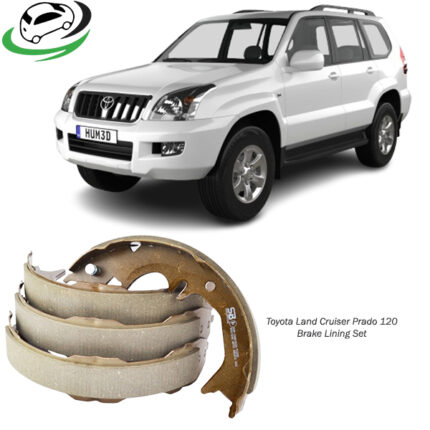-5%
Get Toyota Land Cruiser Prado GRJ150 Cable Parking Brake Assy RH 46420-60112
The cable parking brake assembly (RH) for the Toyota Prado Land Cruiser 120 Series is an essential part of the vehicle’s braking system. It ensures the vehicle remains stationary when parked, especially on slopes or uneven terrain. As with most parking brakes, it functions as a secondary or emergency brake. This guide will provide a comprehensive overview of the cable parking brake assembly (RH), covering its purpose, components, working mechanism, installation, maintenance, and troubleshooting.
1. Purpose and Functionality of the Cable Parking Brake Assembly
The parking brake, also known as the handbrake or emergency brake, operates independently of the main hydraulic braking system. Its primary purpose is to lock the rear wheels in place when the vehicle is parked, preventing any movement. In the Toyota Prado Land Cruiser 120 Series, the parking brake cable assembly ensures that the vehicle can remain safely stationary, even when parked on a steep incline.
Key Functions:
- Secures the vehicle when parked: Prevents the vehicle from rolling when parked, ensuring the driver can leave it safely, regardless of the terrain.
- Emergency brake: In case the primary hydraulic brake system fails, the parking brake can provide limited braking to bring the vehicle to a halt.
The parking brake system in most vehicles is mechanical and engages the rear brakes via cables. In the Prado 120 Series, the RH (right-hand) cable controls the right rear wheel’s braking function, ensuring balanced braking power when the handbrake is applied.
2. Components of the Cable Parking Brake Assembly (RH)
The cable parking brake assembly is a mechanical system that consists of several interconnected components, working together to control the rear wheels of the vehicle when the handbrake is applied. Key components include:
a. Parking Brake Lever:
This is the lever or pedal inside the vehicle that the driver uses to engage or disengage the parking brake. In the Prado 120 Series, it is often manually operated and pulls the cables when activated.
b. Cable Assembly:
This is the actual cable responsible for transmitting force from the parking brake lever to the rear brake mechanisms. The cable assembly is typically made from strong, flexible steel wire enclosed in a protective sheath to resist wear, corrosion, and external elements.
c. Equalizer Mechanism:
The equalizer balances the force applied by the parking brake lever between the left and right rear brake cables. This ensures that both rear wheels are locked with equal force when the handbrake is engaged.
d. Brake Shoes (Drum Brakes) or Calipers (Disc Brakes):
In the Prado 120 Series, the parking brake mechanism usually engages the rear brake shoes in drum brake configurations, applying pressure to lock the wheel.
e. Return Springs:
These springs help to return the parking brake system to its original position once the brake is disengaged. They ensure that the cable remains taut and does not become loose over time.
3. Working Mechanism of the Cable Parking Brake
The parking brake in the Toyota Prado Land Cruiser 120 Series operates through a mechanical system that transmits force from the lever or pedal to the rear brakes via cables. Here’s a breakdown of how the system works:
- Engaging the Parking Brake:
- When the driver pulls the parking brake lever (or presses the parking brake pedal, depending on the design), tension is applied to the parking brake cables.
- The tension travels down the cable assembly and causes the brake shoes (in drum brakes) or calipers (in disc brakes) to press against the wheel drums or rotors.
- Locking the Rear Wheels:
- The brake shoes or calipers lock the rear wheels in place by pressing tightly against the drum or rotor, preventing the vehicle from rolling.
- The equalizer ensures that both left and right cables receive equal force, keeping both rear wheels locked with balanced pressure.
- Disengaging the Parking Brake:
- Releasing the lever or pedal releases the tension on the cables, allowing the return springs to retract the brake shoes or calipers and disengage the rear brakes.
This simple mechanical system is highly reliable and effective for ensuring the vehicle remains stationary, particularly in off-road situations where the Toyota Prado often excels.
4. Installation of Cable Parking Brake Assembly (RH)
Installing a cable parking brake assembly (RH) is a process that requires some mechanical knowledge. Here’s a step-by-step guide for installing this assembly in the Toyota Prado 120 Series:
a. Tools and Equipment Needed:
- Jack and jack stands
- Wrench set
- Screwdrivers
- Pliers
- New parking brake cable assembly (RH)
- Torque wrench
b. Step-by-Step Installation Process:
- Raise the Vehicle:
- Place the vehicle on a level surface and use a jack to lift the rear of the vehicle. Support it with jack stands to ensure safety.
- Remove the Rear Wheel:
- Loosen the lug nuts and remove the rear wheel to gain access to the brake assembly and the cable connection points.
- Disconnect the Old Parking Brake Cable:
- Locate the parking brake cable under the vehicle and trace it to the connection at the brake assembly.
- Disconnect the cable from the brake lever mechanism inside the vehicle (often found under the center console or dashboard).
- Remove the cable from any retaining clips or brackets.
- Detach the Cable from the Rear Brake Assembly:
- Depending on whether the Prado uses drum or disc brakes, disconnect the parking brake cable from the brake shoes or calipers. This may require loosening screws or bolts securing the cable to the brake assembly.
- Install the New Cable:
- Position the new parking brake cable assembly in the same route as the old one, ensuring it is securely fastened to all retaining clips or brackets.
- Reconnect the cable to the brake lever inside the vehicle.
- Attach the other end of the cable to the rear brake assembly (brake shoes or calipers).
- Test the Parking Brake:
- Before reassembling everything, test the parking brake to ensure that it properly engages and disengages the rear brakes.
- Reassemble the Components:
- Once satisfied with the installation, reassemble the brake components and reinstall the rear wheel.
- Lower the vehicle and perform a final test of the parking brake for proper operation.
5. Maintenance and Troubleshooting
Maintaining the parking brake assembly is crucial for ensuring it functions properly over time. Regular inspections and timely repairs can prevent failure or decreased performance.
a. Maintenance Tips:
- Inspect the Cable for Wear:
- Over time, the parking brake cable may wear out, stretch, or corrode. Regularly check the cable for signs of fraying, rust, or damage. Replace it as needed to maintain functionality.
- Lubricate the Cable:
- The cable assembly benefits from occasional lubrication to prevent rust and ensure smooth operation. Use a high-quality lubricant to keep the cable moving freely within its protective sheath.
- Check the Brake Shoes/Calipers:
- Regularly inspect the brake shoes or calipers to ensure they are in good condition and properly engaging when the parking brake is applied.
- Test the Parking Brake:
- Periodically test the parking brake by parking on an incline and ensuring that it holds the vehicle stationary without slipping.
b. Common Issues and Troubleshooting:
- Loose or Unresponsive Parking Brake:
- If the parking brake feels loose or unresponsive, the cable may be stretched or damaged. Adjust the tension or replace the cable if necessary.
- Parking Brake Fails to Engage:
- If the parking brake does not engage, it could be due to worn brake shoes or calipers. Inspect and replace these components as needed.
- Noise During Operation:
- Unusual noises when applying or releasing the parking brake could indicate wear or improper adjustment. Inspect the entire assembly for any issues and make the necessary adjustments.
6. Conclusion
The Cable Parking Brake Assembly (RH) for the Toyota Prado Land Cruiser 120 Series is an essential component of the vehicle’s braking system, ensuring safe parking and providing an emergency braking option. Proper maintenance and timely replacement of worn or damaged components can significantly improve the performance of the parking brake system. By understanding the design, working mechanism, installation process, and common troubleshooting techniques, vehicle owners and automotive professionals can ensure that the parking brake assembly functions optimally, contributing to the overall safety and reliability of the Prado Land Cruiser 120 Series.
Follow us on Facebook for more parts.




Reviews
Clear filtersThere are no reviews yet.